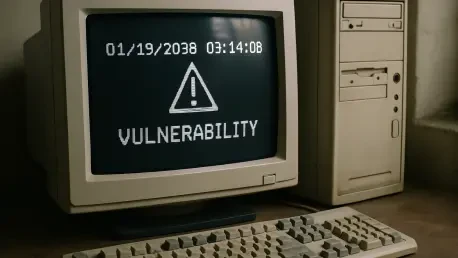Imagine a world where a simple date error could cripple power grids, disrupt military operations, or render smart devices useless overnight. This isn’t science fiction but a real threat posed by the Y2K38 bug, a time-related vulnerability lurking in countless systems worldwide. Often dismissed as a distant problem set for 2038, this issue is already exploitable today, challenging the foundations of cybersecurity and infrastructure stability. This review dives into the technical intricacies of the Y2K38 bug and its cousin, the Year 2036 problem, exploring their immediate risks and the daunting task of mitigation.
Technical Foundations and Origins
The Y2K38 bug stems from a fundamental flaw in how many systems store time using 32-bit signed integers, counting seconds since the Unix epoch of January 1, 1970. When this counter reaches its limit on January 19, 2038, it overflows, resetting the date to December 13, 1901, potentially causing widespread system failures. This isn’t just a quirky glitch but a design limitation in older software and hardware architectures that were never built to handle dates beyond this threshold.
Similarly, the Year 2036 problem affects systems relying on outdated versions of the Network Time Protocol (NTP), which use a time base starting from 1900. On February 7, 2036, this system will also overflow, misrepresenting dates and disrupting time synchronization critical for networked operations. Both issues highlight a historical oversight in computing design, where the long-term scalability of time storage was underestimated.
These vulnerabilities are embedded in a vast array of technology, from legacy industrial systems to modern consumer electronics. Their origins lie in an era when computing resources were scarce, and 32-bit systems seemed sufficient for foreseeable needs. Today, as interconnected devices multiply, this shortsightedness poses a significant risk to global digital infrastructure.
Exploitable Risks in Today’s Landscape
Contrary to the belief that these bugs are future concerns, current research reveals they can be exploited now through sophisticated time manipulation tactics. Techniques such as GPS spoofing and NTP injection allow malicious actors to trick systems into believing it’s already past the critical dates, triggering failures or bypassing security protocols. This immediacy shifts the perception of Y2K38 from a distant glitch to an active cybersecurity vulnerability.
The implications for security mechanisms are profound, especially for systems relying on accurate timekeeping like SSL/TLS certificates and time-based authentication. An attacker exploiting these bugs could invalidate certificates, disrupt logging, or gain unauthorized access, undermining the core principles of data integrity and confidentiality. Such risks are not theoretical but have been demonstrated in controlled environments, raising alarms across the tech community.
Specific sectors, including finance and telecommunications, face heightened threats due to their dependence on precise timing. A manipulated timestamp could disrupt transactions or communication networks, leading to financial losses or service outages. As these vulnerabilities become better understood, the urgency to address them before widespread exploitation grows ever more critical.
Impact Across Industries and Systems
The potential fallout from the Y2K38 and Year 2036 problems spans a broad spectrum of applications, affecting both everyday gadgets and critical infrastructure. Consumer devices such as smart TVs, routers, and even vehicles with embedded systems are at risk of malfunctioning when dates are misinterpreted, potentially leading to data loss or operational failures.
More alarmingly, critical systems like industrial control units, power plants, and military equipment face catastrophic consequences from time errors. A miscalculated date in a nuclear submarine’s navigation system or a power grid’s control software could result in safety breaches or physical harm. These scenarios underscore the far-reaching stakes of ignoring this vulnerability.
Real-world examples already highlight the severity of the issue. Vulnerabilities in devices like Dover Fueling Solutions’ tank gauging systems, used in gas stations, have been identified as susceptible to time manipulation, risking denial-of-service conditions. Such cases serve as a stark reminder that the impact is not hypothetical but already manifesting in specific technologies.
Challenges in Addressing the Threat
Mitigating the Y2K38 and Year 2036 bugs presents a formidable challenge due to the sheer scale of affected systems and the nature of embedded technology. Many legacy and embedded devices cannot be easily updated, as they lack the capability for software patches or hardware upgrades. This unpatchable nature complicates efforts to secure vast swaths of infrastructure.
Transitioning to 64-bit architectures, which can handle dates far beyond 2038, is a viable solution but comes with significant costs and technical hurdles. For organizations managing older systems, the expense of replacing hardware or rewriting software often outweighs perceived risks, delaying necessary action. This inertia exacerbates the problem, leaving critical systems exposed.
Current efforts, such as patches from vendors like Dover and initiatives like the Epochalypse Project, show progress but fall short of a comprehensive fix. Global coordination is essential, yet the diversity of affected systems and stakeholders makes unified action difficult. Without a concerted push, many vulnerabilities will persist, waiting to be exploited.
Future Strategies and Recommendations
Looking ahead, strategic planning must prioritize the identification and protection of the most critical systems vulnerable to these time bugs. Frameworks like the Common Vulnerability Scoring System (CVSS) offer a structured approach to assess and rank risks, guiding resource allocation toward high-impact areas. Such tools can help focus efforts on infrastructure where failure would be most devastating.
Developing contingency plans for unpatchable systems is equally vital, ensuring that alternative processes or manual overrides are in place to maintain functionality during a crisis. Industries must invest in resilience, preparing for scenarios where time errors could disrupt operations. Proactive measures now can mitigate the severity of potential incidents in the coming years.
Technological advancements may also play a role, with innovations in time storage or synchronization protocols offering long-term solutions. However, the window to implement these changes is narrowing, especially as the critical dates of 2036 and 2038 approach. Stakeholders must act decisively, leveraging both existing tools and emerging research to safeguard digital ecosystems.
Final Thoughts and Next Steps
Reflecting on this review, the exploration of the Y2K38 and Year 2036 vulnerabilities reveals a pressing cybersecurity challenge that demands immediate attention. The technical deep dive exposes how deeply embedded these flaws are in modern systems, while the analysis of current exploitability underscores the urgency of response. It is evident that the scale of potential disruption surpasses historical precedents like the Y2K bug, given the proliferation of connected devices.
Moving forward, the focus should shift toward fostering international collaboration among governments, industries, and researchers to pool resources and expertise. Establishing a global task force dedicated to time-based vulnerabilities could streamline mitigation efforts, ensuring that best practices are shared and implemented widely. Additionally, investing in public awareness campaigns could encourage smaller organizations and individuals to assess their own systems for risks, broadening the scope of protection.
Ultimately, the path ahead requires innovation in both policy and technology, pushing for incentives that accelerate the adoption of 64-bit systems in critical sectors. By learning from past oversights and committing to sustained action, the tech community can transform this looming threat into a manageable challenge, securing a safer digital future for all.









